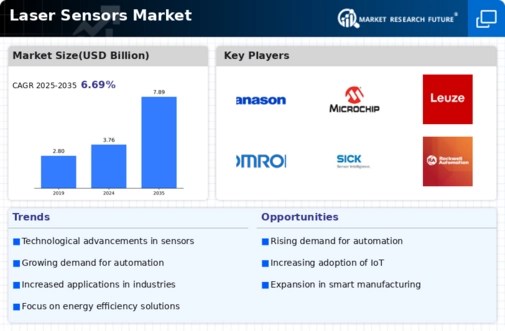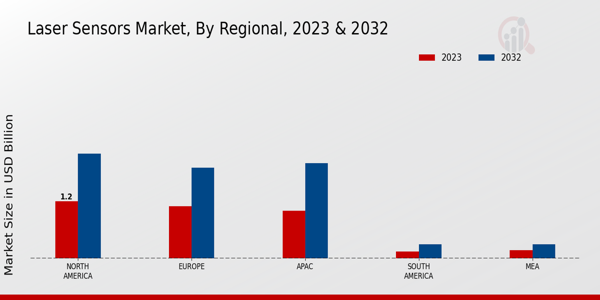Rising Safety Standards
The Global Laser Sensors Market Industry is influenced by the rising safety standards across various sectors. Regulatory bodies are increasingly mandating the use of advanced sensing technologies to ensure workplace safety and compliance. For instance, laser sensors are utilized in industrial environments to detect hazardous conditions and prevent accidents. This heightened focus on safety is driving the adoption of laser sensors, contributing to the market's anticipated growth to 7.89 USD Billion by 2035. As industries prioritize safety measures, the demand for reliable and accurate laser sensors is likely to increase, further propelling market expansion.
Market Growth Projections
The Global Laser Sensors Market Industry is projected to experience substantial growth, with estimates indicating a market value of 3.76 USD Billion in 2024 and a potential increase to 7.89 USD Billion by 2035. This growth trajectory suggests a compound annual growth rate (CAGR) of 6.97% from 2025 to 2035. The expansion is driven by various factors, including technological advancements, increased automation, and the rising demand for safety and environmental monitoring. These projections highlight the dynamic nature of the laser sensors market and its potential to adapt to evolving industry needs.
Technological Advancements
The Global Laser Sensors Market Industry is experiencing rapid technological advancements that enhance sensor capabilities. Innovations in laser technology, such as improved wavelength precision and miniaturization, enable more accurate measurements across various applications. For instance, advancements in LiDAR technology are being utilized in autonomous vehicles, which require precise distance measurements for navigation. This trend is expected to drive the market's growth, with projections indicating a market value of 3.76 USD Billion in 2024. As technology continues to evolve, the demand for sophisticated laser sensors across industries such as automotive, aerospace, and manufacturing is likely to increase.
Growing Demand in Automation
The Global Laser Sensors Market Industry is witnessing a surge in demand due to the increasing adoption of automation in various sectors. Industries such as manufacturing and logistics are integrating laser sensors for enhanced precision and efficiency in operations. For example, laser sensors are employed in automated guided vehicles (AGVs) to facilitate accurate navigation and obstacle detection. This trend aligns with the projected compound annual growth rate (CAGR) of 6.97% from 2025 to 2035, indicating a robust growth trajectory. As companies strive for operational excellence, the reliance on laser sensors for automation is expected to expand significantly.
Environmental Monitoring Initiatives
The Global Laser Sensors Market Industry is benefiting from increased environmental monitoring initiatives. Governments and organizations are investing in technologies that facilitate the monitoring of air quality, pollution levels, and climate change. Laser sensors play a crucial role in these initiatives by providing accurate and real-time data for environmental assessments. For instance, laser-based remote sensing technologies are utilized to monitor greenhouse gas emissions. As global awareness of environmental issues rises, the demand for laser sensors in monitoring applications is likely to grow, supporting the market's overall development.
Expanding Applications in Healthcare
The Global Laser Sensors Market Industry is expanding into the healthcare sector, where laser sensors are being utilized for various applications, including diagnostics and surgical procedures. The precision offered by laser sensors enhances the accuracy of medical devices, leading to improved patient outcomes. For example, laser-based imaging systems are employed in non-invasive diagnostics, allowing for early detection of diseases. This trend is indicative of the market's potential growth, as healthcare continues to embrace advanced technologies. The integration of laser sensors in medical applications is expected to contribute significantly to the overall market expansion in the coming years.
























